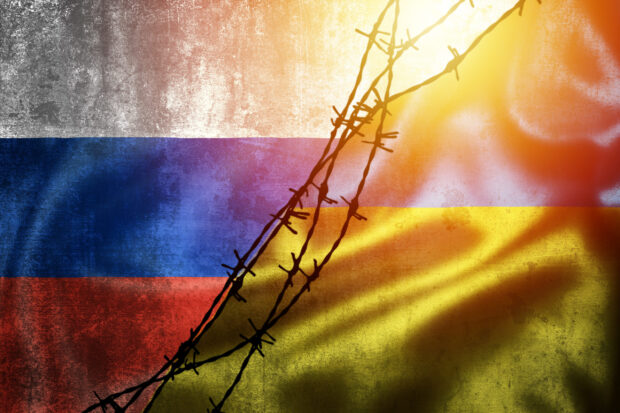Global insurance losses from the Russia-Ukraine war could range from $16 billion to $35 billion, with reinsurers expected to assume 50 percent of those claims, according to a report published by S&P Global Ratings.
While recent articles in the press have focused on the industry’s aviation exposure to leased jets that have been confiscated and grounded in Russia, other specialty lines are also exposed—such as trade credit, political risk (contract frustration, agriculture and commodities), cyber, political violence and marine hull war, said S&P.
“We share the view of major market players that the ongoing conflict will represent a major claim to the market in 2022. We believe that specialty lines will be the most exposed, with aviation hardest hit,” said S&P in its report titled “Russia-Ukraine Conflict Adds to a Bumpy Start to 2022 for Global Reinsurers.”
This week, for example, Dublin-based AerCap Holdings, the world’s largest aircraft lessor, announced it has submitted a $3.5 billion claim to its insurers.
On its own, aviation losses could range from $6 billion to $15 billion of the overall potential claims of $16-$35 billion, which will take lengthy legal wrangling in courts and many years to settle, the report indicated. For the purposes of comparison, S&P cited the example of a New Jersey court that earlier this year ruled in favor of the U.S. pharmaceutical company Merck & Co. for a $1.4 billion claim against its insurers under its all-risk property insurance policy following the 2017 NotPetya cyber attack.
Whatever the ultimate price tag is for the Russia-Ukraine war, global reinsurers are likely to assume about one-half of the potential specialty insurance losses, resulting in an earnings event for most reinsurers and a capital event for a few outliers, said S&P.
S&P looked at three scenarios to develop its estimates.
Scenario 1
Under Scenario 1, S&P calculates a $16 billion total loss, which assumes global insured aviation losses of $6 billion and $10 billion from the other specialty lines. (The top 21 global reinsurers are likely to carry 50 percent of that amount, S&P said. See below for S&P’s list of top 21 reinsurers.)
Diving into its aviation loss calculations, S&P said this base-case assumption in Scenario 1 reflects industry reports that only 78 aircraft out of 515 aircraft leased to Russian airlines have been safely recovered.
“From discussions with market participants, we understand that the appraised insured value of all the 515 aircraft is about $12 billion,” said S&P, noting, however, the insured loss is likely to be lower because of the 78 recovered aircraft. “We also assume that some coverage has been cancelled and some potential court decisions do not foresee the highest sums insured and coverage.”
Scenario 2
Under Scenario 2, S&P calculates a higher figure for aviation and specialty lines’ losses of a total of $27 billion, comprising $12 billion and $15 billion, respectively. (Once again, the top 21 global reinsurers are likely to carry 50 percent of that amount.)
Its calculation for aviation claims broadly reflects “the appraised insured value of the 515 aircraft, that most policies are not cancellable, and that a majority of potential court decisions fall in favor of lessors versus insurers in terms of sums at risk,” S&P continued.
Scenario 3
Under Scenario 3, the total losses for aviation and specialty lines reach a total of $35 billion, which assumes aviation insured losses of $15 billion and specialty lines losses of about $20 billion. (The top 21 global reinsurers could be on the hook for 50 percent of that amount.)
Detailing its assumption for aviation, S&P said it reflects “even higher losses compared to the appraised insured value.”
“This reflects potential uncertainties surrounding the exact insured value, the assumption that the vast majority of policies are not cancellable, and that the vast majority of potential court cases rule in favor of lessors with the highest possible insured sums at risk (if, for example, the insured event is classified as theft instead of an act of war),” the report added.
These three scenarios carry “significant uncertainties” but provide “an indication of the potential exposures for the global insurance industry and the share that may be assumed by the top 21 global reinsurers,” the report went on to say.
Nevertheless, S&P said, the reinsurance sector’s annual expected pre-tax profit of about $22.5 billion, coupled with the natural catastrophe budget of about $13 billion, should provide a sufficient buffer to absorb these losses.
“However, we believe that for a few reinsurers with a large aviation market share or aviation losses in combination with other losses stemming from the Russia-Ukraine conflict, it could become a capital event.”





















 First Atlantic Hurricane Forecast for 2026 Suggests Season Close to 30-Year Norm
First Atlantic Hurricane Forecast for 2026 Suggests Season Close to 30-Year Norm  Five AI Trends Reshaping Insurance in 2026
Five AI Trends Reshaping Insurance in 2026  Why ‘Good Enough’ Is Killing Insurance: The Hidden Cost of Satisficing
Why ‘Good Enough’ Is Killing Insurance: The Hidden Cost of Satisficing 




